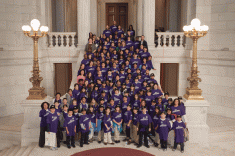 By Ellen Winn, Executive Vice President, 50CAN: The 50-State Campaign for Achievement Now
By Ellen Winn, Executive Vice President, 50CAN: The 50-State Campaign for Achievement Now
Education advocacy is the hot item of the year. After years of focusing almost solely on educational practice and structure (and amassing a serious list of “what works”), there is consensus in our field that if we don’t get serious about removing political obstacles that stand in the way of implementing these proven strategies, we will never be able to make the widespread change that is necessary to close the achievement gap.
School reform advocates are lucky to not have to go it alone. There is an incredible amount to be learned from our older siblings in the advocacy world: the environmental movement, the civil rights movements, the movements for equal rights for women and the LGBT community. When it comes to education advocacy, we don’t have to reinvent the wheel or repeat past mistakes. Instead, we should be taking lessons from successful advocacy movements in other fields.
My colleagues and I at 50CAN: The 50-State Campaign for Achievement Now spend a lot of time talking, thinking and debating other advocacy movements and their specific tactics. We’ve got a running list of what we’re learning:
Lesson 1. Research has to be tangible.
Good research is useless unless it is explained to and understood by the people with the power to use it to make policy.
The cigarette excise tax enacted in 1985, which dramatically reduced cigarette consumption by upping the price of cigarettes, was the outgrowth of a smart decision by anti-tobacco advocates. The fledgling anti-tobacco movement realized that the research—well known only in academic circles—needed a wider audience if they were ever going to get anyone to act on it. So the Institute for the Study of Smoking Behavior and Policy at Harvard University commissioned public health economist Ken Warner to write a digest of all the research on cigarette consumption in terms that lawmakers would easily understand. The study cut to the chase, spelling out in real figures the number of people who would quit or not begin smoking in the first place with the introduction of an excise tax. Warner found that if the price of cigarettes were raised by eight cents, 1.8 million people, including over 400,000 teenagers and another 500,000 young adults aged 20 to 25 would live to breathe another day. The advocates gave the lawmakers the Cliff’s Notes they needed to pass legislation that literally saved thousands of lives.
Lesson 2. A successful advocacy message speaks in terms that people understand. 
Leave the jargon behind and speak in terms easily understood by all citizens.
The “Back to Sleep” campaign – credited for reducing Sudden Infant Death Syndrome by more than 50 percent – translated reams of complex research into a three-word message. The public didn’t need to read clinical trials or debate the relative merits of infant care; they needed to know what to do. The campaign uses a direct and powerful message to save infants’ lives.
Lesson 3. Get your message out there by any means necessary.
If folks don’t hear your message they can’t take action.
In the aftermath of the BP Gulf oil spill, The Environmental Defense Fund posted a video on YouTube with images from the spill set to the version of “Over the Rainbow” performed on an episode of Glee. It’s been viewed more than 335,000 times.
YouTube, viral video, Facebook, Twitter – have at it – social media is cheap and wildly effective. The Girl Effect is another example of a compelling advocacy message spread through a nontraditional channel. Their videos have been viewed over 2.7 million times (!) and they’ve made it ridiculously easy to share them. (Full disclosure: I’m obsessed with all of their videos; brilliant!)
Lesson 4. Look beyond the usual suspects to spread the ed reform gospel.
Partners-in-the-making, from religious organizations to businesses and community groups are everywhere. The more your coalition looks like a collection of strange bedfellows the better. By bringing seemingly disparate groups together you draw increased attention and make your cause harder to pigeonhole and dismiss.
More than 47 diverse groups came together to form The Coalition Against the Prison, which protested the construction of a prison in East Los Angeles. The coalition had local chambers of commerce, education organizations, neighborhood associations and local chapters of Kiwanis, Lions, Optimists, Rotary and Boys and Girls clubs. They didn’t ultimately win their campaign, but they came very close against incredible odds, thanks to their strange, and determined, bedfellows.
Lesson 5. Create a moment of drama.
Education policy is not inherently sexy. Finding ways to bring attention and life to a seemingly dry topic – often via creative events – can be a powerful way to garner media attention and new supporters as well as energizing your base.

Mothers Against Drunk Driving (MADD) restored a crucial provision of a drunk driving law in Hawaii by staging a dramatic event. MADD chose Memorial Day to stage an event in front of Hawaii’s Eternal Flame war memorial. The holiday is both a slow news day and burdened with high traffic accidents and fatalities. At the Memorial, with the news cameras rolling, Mothers Against Drunk Driving reminded Hawaiians to remember those killed on highways as well as in wars. They launched a campaign targeted at Hawaii’s Senate President, the only lawmaker with the ability to call a special session to address penalties for drunk drivers. They voiced a powerful and unifying message: “After July 1st, most drunk drivers will not lose their license to drive. They will be legally sharing the roads with us and our families.” Mothers Against Drunk Driving garnered enough support to force a special session and fix the problem.
Earlier this year, over 200 kids in purple Be a Superhero t-shirts, showed up at an education finance committee hearing at the state capitol in Providence, Rhode Island. They were brought together by my colleagues at RI-CAN: The Rhode Island Campaign for Achievement Now as part of our 2011 “Be a Superhero” legislative campaign to show their support for legislation related to charter school buildings. Budget hearings are usually not the stuff of excitement and news stories, but this one was.
This handful of examples is literally just the tip of the iceberg. There are a number of terrific resources that document advocacy lessons across the spectrum.
A good place to start is Forces for Good, Leslie Crutchfield and Heather McLeon Grant’s analysis of 12 rock-star nonprofits’ “secrets of success.” Up in Smoke: From Legislation to Litigation in Tobacco Politics gives a fascinating blow-by-blow of the anti-tobacco advocacy story.
Other strong resources include the Kennedy School’s case program, which provides in-depth case studies of successful advocacy campaigns (one caveat: you have to pay). The Kellogg Foundation has a number of useful case studies available on its website, including studies on direct lobbying, mobilizing and organizing, and advocating through education. And finally, the Center for Lobbying in the Public Interest has a great collection of advocacy success stories on its website.
Ellen Winn serves as the Executive Vice President of 50CAN. Prior to joining 50CAN, Ellen was the Director of the Education Equality Project, a national education advocacy organization whose sole focus is closing the racial and ethnic achievement gap in public education. Ellen holds a BA from Haverford College in urban studies and a Masters in Public Policy from the University of California, Berkeley.
